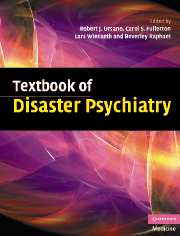Book contents
- Frontmatter
- Contents
- List of contributors
- Preface
- Part I Introduction
- Part II Foundations of disaster psychiatry
- 2 Epidemiology of disaster mental health
- 3 Children and disasters: public mental health approaches
- 4 Disaster ecology: implications for disaster psychiatry
- 5 Neurobiology of disaster exposure: fear, anxiety, trauma, and resilience
- Part III Clinical care and interventions
- Part IV Special topics
- Part V Public health and disaster psychiatry
- Index
- References
2 - Epidemiology of disaster mental health
from Part II - Foundations of disaster psychiatry
Published online by Cambridge University Press: 09 August 2009
- Frontmatter
- Contents
- List of contributors
- Preface
- Part I Introduction
- Part II Foundations of disaster psychiatry
- 2 Epidemiology of disaster mental health
- 3 Children and disasters: public mental health approaches
- 4 Disaster ecology: implications for disaster psychiatry
- 5 Neurobiology of disaster exposure: fear, anxiety, trauma, and resilience
- Part III Clinical care and interventions
- Part IV Special topics
- Part V Public health and disaster psychiatry
- Index
- References
Summary
Introduction
Psychiatric epidemiology provides a broad foundation for general understanding of the mental health effects of extreme trauma and secondarily helps to inform the field of mental health response to less extreme stress. Disaster mental health has considerable relevance in today's world, with disasters and terrorism increasingly occupying concerns of communities internationally.
The study of the mental health effects of traumatic events suffers from inherent methodological limitations. Studies of personal traumatic events endemic to community settings (such as motor vehicle accidents, gunshot wounds, and violent assault) suffer from confounding resulting from the nonrandom nature of their occurrence.
Pre-existing characteristics of individuals may be associated with risk for exposure to traumatic events (Breslau et al., 1998), such as drug abuse, other psychopathology, high novelty-seeking and low harm-avoidance characteristics of personality, and low socioeconomic status (Breslau et al., 1991). Risk for exposure to traumatic events in community settings is thus confounded with the mental health consequences of them. Studies of trauma in community settings may therefore be unable to determine what part of post-trauma effects is due to the traumatic experience, and what is pre-existing in individuals predisposed to such exposure. Because pre-existing characteristics of individuals exposed to trauma in individual incidents in communities determine their status after the event, findings from studies of other kinds of traumatic events may not apply to populations affected by disasters.
Keywords
- Type
- Chapter
- Information
- Textbook of Disaster Psychiatry , pp. 29 - 47Publisher: Cambridge University PressPrint publication year: 2007
References
- 17
- Cited by



